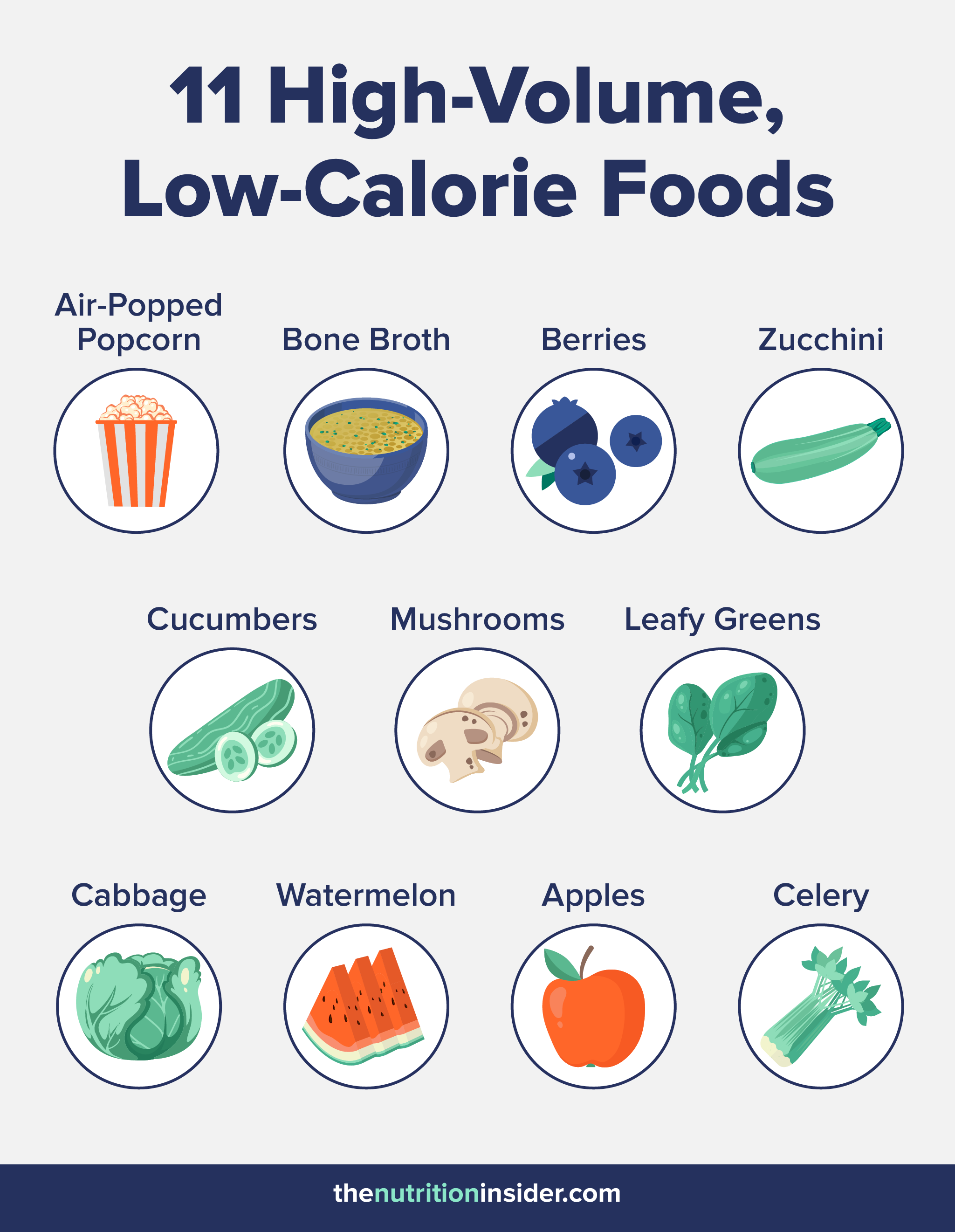Save $40 on your initial consult with a TNI Dietitian!
Talk to a real Dietitian for only $99: Schedule Now
Evidence Based Research To fulfill our commitment to bringing our audience accurate and insightful content, our expert writers and medical reviewers rely on carefully curated research.
Read Our Editorial Policy
If you want to eat more and still lose weight, high-volume, low-calorie foods are your secret weapon (think water-packed fruits and vegetables).
These foods literally fill up your stomach without piling on calories, making it easier to stay full, satisfied, and in a calorie deficit (aka the key to weight loss).
This concept gained popularity in the early 2000s with the Volumetrics Diet, which focuses on eating low-calorie, nutrient-dense foods that physically take up more space in your stomach.
Most high-volume foods are water-packed fruits and vegetables, but there are also other satisfying options to choose from.
Let’s take a look at the top 11 low-calorie, high-volume foods (plus some moderate-calorie options that are even more filling).

Popcorn is a classic high-volume, low-calorie food—as long as you’re not dousing it in butter.
Many people don’t realize that popcorn on its own is a healthy, fiber-rich whole grain, containing about 2.5 grams of fiber per two cups.
Air-popped popcorn is easy to make at home—plus, you can control the toppings. A light spray of olive oil, a sprinkle of sea salt, or even some nutritional yeast can add a cheesy flavor without too many extra calories.
Calories Per Serving: 60 calories per 2 cups of air-popped popcorn
Bone broth is one of the few high-volume and low-calorie foods that is also loaded with protein.
Although it’s become pretty trendy in recent years, bone broth (or variations of it) has actually been around for centuries—in fact, all broth used to be bone broth.
The process of making bone broth involves slowly simmering animal bones or connective tissue (usually from cows or chickens) for hours or even days.
This simmering method extracts collagen, protein, and other nutrients into the broth, creating a nutrient-dense liquid that contains more protein than regular chicken or beef broth.
Bone broth can vary in protein content, but it typically contains approximately 10 grams per cup for about 40 calories.
Calories Per Serving: 35-50 calories per 1 cup of bone broth (8oz)
Weekly menu, grocery list, macros—one consult unlocks it all.
Weekly menu, grocery list, macros—one consult unlocks it all.

Zucchini is a versatile veggie that’s high in water (aka volume) and low in calories, making it perfect for weight loss. You can sauté, roast, or spiralize it into “zoodles” as a low-calorie pasta swap or addition.
Mix regular spaghetti with zoodles for a lighter, fiber-rich dish that still satisfies—a smart way to cut calories without giving up the comfort and taste of real pasta.
Zucchini bulks up meals without adding many calories and takes on the flavor of whatever you cook it with, including sauces, herbs, or seasoning blends. As a bonus, one medium zucchini provides over half your daily vitamin C needs (who needs oranges?), plus vitamin B6 and folate.
Calories Per Serving: About 30 calories per medium zucchini
Cucumbers are essentially crunchy water, making them a perfect food for volumetric eating. With over 95% water content, you can eat a ton of them without racking up calories.
They’re also refreshing, hydrating, and offer a satisfying crunch that can help replace chips or crackers when you want something crispy.
While not super nutrient-dense, they do provide small amounts of vitamin K and potassium.
Calories Per Serving: About 20 calories per small cucumber (6 inches)
Celery is the quintessential low-cal “diet food”—but it doesn’t have to be boring.
With over 95% water and about 1 gram of fiber per stalk, celery is great for providing volume and a satisfying crunch.
If you’re not a fan of plain celery (you’re not alone), it’s a perfect vehicle for nutrient-dense dips like hummus, salsa, or Greek yogurt-based dressings.
While celery isn’t packed with micronutrients, it does offer a bit of vitamin K, folate, and antioxidants.
Calories Per Serving: About 10 calories per medium stalk
Mushrooms are a secret superfood that many people underestimate—in both flavor and nutritional value.
With a high water content and a meaty texture that both vegans and carnivores can appreciate, mushrooms bulk up dishes like soups, stir-fries, or salads without piling on calories.
They also offer a decent amount of fiber, antioxidants (like the rare ergothioneine), and vitamin D (only if grown in sunlight or under UV light).
Calories Per Serving: About 15 calories per cup (sliced)
Everyone knows that you should eat your greens—and for good reason!
Leafy greens like spinach, kale, arugula, and Swiss chard are classic high-volume, low-calorie foods that are loaded with nutrients.
They provide vitamins A, C, K, folate, potassium, magnesium, and antioxidants like lutein, zeaxanthin, and kaempferol.
If you don’t love them raw, try sautéing them (especially spinach), roasting them (kale is great for this), or blending them into a smoothie.
Calories Per Serving: About 5-15 calories per cup (raw, loosely packed)
Cabbage is a high-volume, low-calorie veggie that deserves way more credit.
With only about 22 calories per cup, it’s packed with fiber, vitamin C, vitamin K, and beneficial plant compounds like glucosinolates.
It’s also super versatile—enjoy it raw and shredded in salads, fermented as sauerkraut, or roasted to bring out its natural sweetness and completely transform the flavor.
Calories Per Serving: About 22 calories per cup (raw)
As the name implies, watermelon is packed with water (over 90%), making it perfect for volumetric-style eating.
A one-cup serving has just about 45 calories, yet it still delivers vitamin C, beta-carotene (a precursor to vitamin A), and the antioxidant lycopene, which is linked to heart health and reduced inflammation.
However, it’s also higher in sugar than some fruits, so pairing it with protein, fat, or fiber can help balance blood glucose.
Calories Per Serving: 45 calories per cup (diced)
Apples are a super satisfying low-calorie, high-volume food that are surprisingly filling (have you ever really wanted a second apple?).
With 4 grams of fiber per fruit and lots of water, apples can help curb hunger—especially when paired with fat, fiber, or protein (like peanut butter).
Calories Per Serving: About 95 calories per medium apple
Berries like strawberries, raspberries, and blackberries are loaded with antioxidants (like flavonoids and anthocyanins) and are pretty low in sugar compared to other fruits.
They’re also high in water and fiber, which makes them ideal for volume eating (by the way, raspberries are a fiber superstar, with 7g per cup).
Blackberries, raspberries, and cranberries have the lowest sugar content, but all berries are excellent choices for weight loss.
Calories Per Serving: About 60-85 calories per cup
While high-volume, low-calorie foods are great for filling your stomach, they should absolutely not be the only foods you eat—otherwise, you run the risk of undereating calories, protein, healthy fats, and vital nutrients.
As most people won’t be satisfied by a meal of celery and cabbage alone, pairing these protein-rich foods below with the high-volume, low-calorie foods above is an excellent strategy for stabilizing your blood sugar and boosting satiety and satisfaction.
Satiety is key for sticking to a calorie deficit without feeling miserable and hangry, so these are thoughtful additions to a weight loss plan:
A list of high-volume, low-calorie foods is a great starting point, but balancing them with more satiating, higher-calorie options can be tricky, as your diet shouldn’t consist solely of low-calorie foods.
That’s where a Registered Dietitian (RD) comes in.
An RD can help you build a plan that’s not just practical and realistic but also sustainable, so you don’t have to deal with the ups and downs of yo-yo dieting.
Whether you’re feeling stuck in an all-or-nothing mindset, constantly hangry, or not seeing the results you want, an RD can help personalize your strategy, adjust macros and portion sizes, and troubleshoot the roadblocks in your path.
Ready to take control of your health journey and feel satisfied without starving yourself? Book an intro consultation with one of our RDs today and get personalized guidance.